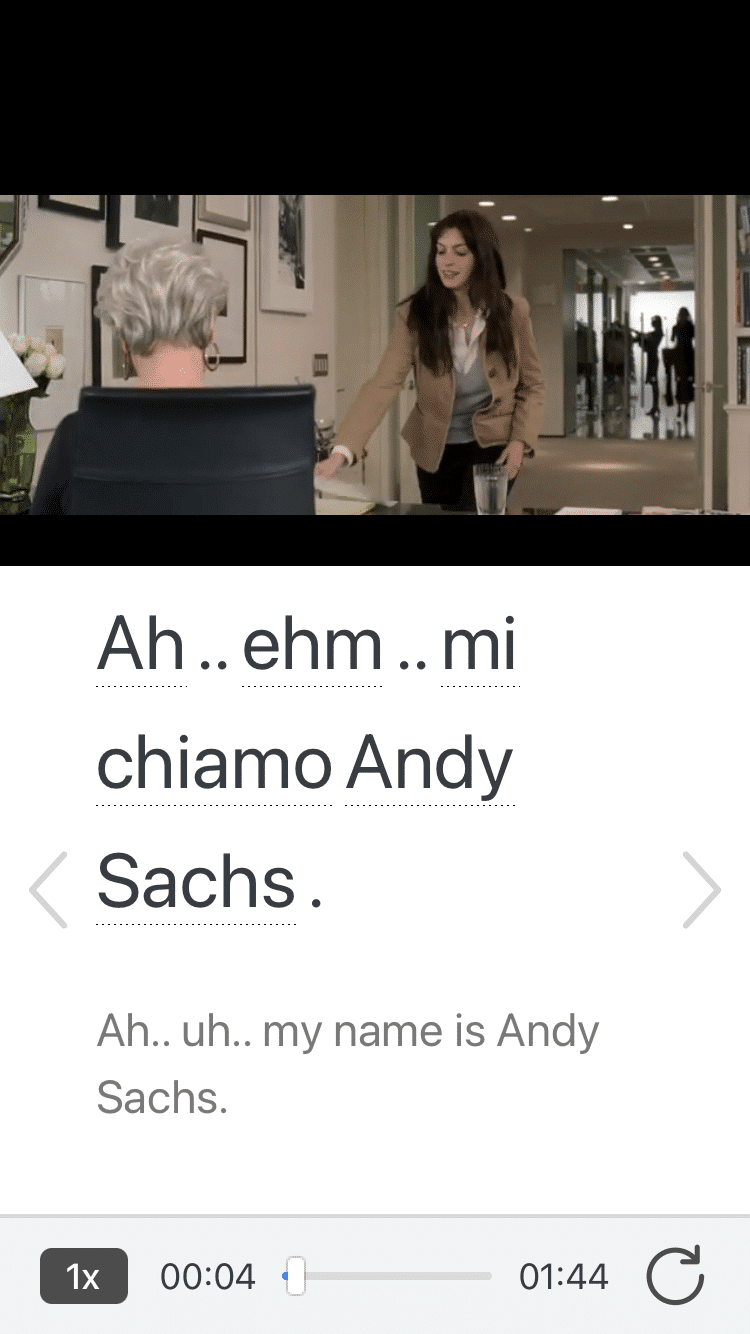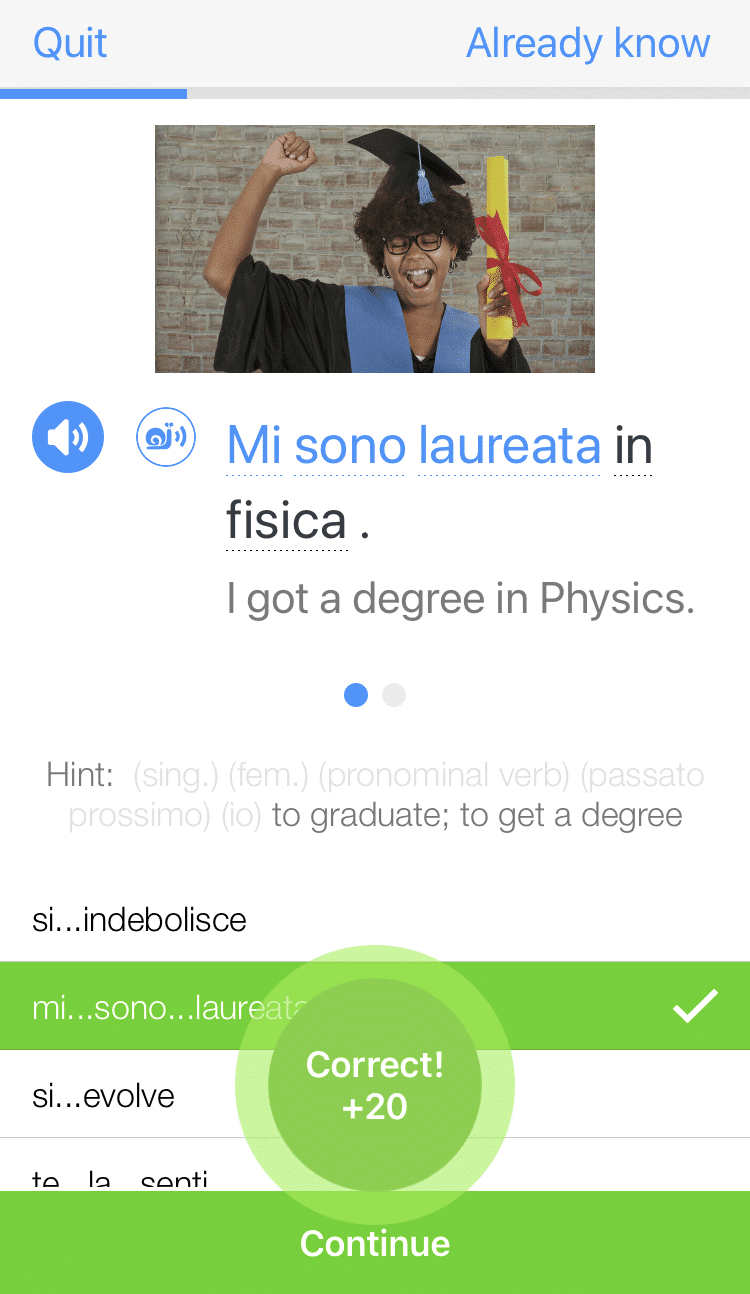
Reflexive Verbs in Italian: A Guide to Their Uses and Conjugations
What have you done so far today?
Did you get dressed and then sit down to study some Italian?
While all the activities I mentioned seem like nothing special in English, in Italian the verbs these activities use are part of a group we call reflexive verbs.
But what are reflexive verbs in Italian? Why do we use them and how do they work? Let’s find out!
Contents
- What Makes an Italian Verb Reflexive
- How to Conjugate Reflexive Verbs in the Present Tense
- How to Form Italian Reflexive Verbs in Past and Compound Tenses
- How to Conjugate Italian Reflexive Verbs in Other Tenses
- Reflexives in the Infinitive and Imperative
- Practice Italian Reflexive Verbs Online
- And One More Thing...
Download: This blog post is available as a convenient and portable PDF that you can take anywhere. Click here to get a copy. (Download)
What Makes an Italian Verb Reflexive
First and foremost, reflexive verbs are followed by the pronoun si in their infinitive form. Si means “to oneself” and it lets us know that the verb (the action) is being done to the person performing the action (the subject).
This is in contrast to actions that happen to another person or object instead of the self.
For example, let’s look at two verbs: lavare (to wash) and lavarsi (to wash oneself).
The first, lavare, can be used with an object, such as in the example lavo la macchina (I wash the car) where the subject (I) is washing an object (a car).
The verb lavarsi, however, is used to say things like mi lavo di mattina (I wash myself in the morning). The reflexive form of mi lavo shows that the washing is happening to the self, not to another person or object.
Take a look at some other common reflexive verbs:
| svegliarsi | To wake up |
| farsi il bagno | To take a bath |
| addormentarsi | To fall asleep |
| divertirsi | To enjoy oneself |
| chiamarsi | To be called/to call oneself |
| pettinarsi | To comb one's hair |
With some verbs, it is easy to figure out which ones will be reflexive. For example, the verb lavarsi (to wash oneself) is obvious since “oneself” is in the English translation.
Other reflexive verbs, however, are a little trickier.
Take, for example, the verbs farsi la doccia (to shower) or sedersi (to sit down). While there is no “oneself” in the translation, it should be evident that the person taking the shower is showering themselves and the person sitting down is sitting themselves down.
Sometimes, it just takes a little in-depth thought about why an action is reflexive. You can also simply learn some common reflexive verbs in Italian right off the bat to help you out in the long run.
Many reflexive verbs can have a non-reflexive form like the lavare example above. However, we are going to focus solely on reflexive forms in this post.
As you can imagine, there are a few additional steps to conjugating a reflexive verb. Let’s get to know them.
How to Conjugate Reflexive Verbs in the Present Tense
Reflexive verbs conjugate differently from non-reflexive verbs in one crucial way: The verbs change their endings to reflect their subjects like regular verbs, but they also have to change their reflexive pronouns accordingly.
Let’s get the easy stuff out of the way first: Most reflexive verbs follow the regular conjugation patterns of their -are, -ire and -ere endings. In other words, the same present tense endings for these verbs in non-reflexive forms are used in the reflexive forms as well.
Something new you will have to learn is the use of reflexive pronouns. These are placed before the verb itself but after the subject (if you are using a subject).
For singular forms, mi is used in place of io, ti with tu, si with lui, lei and Lei.
For plural forms, ci is used in place of noi, vi with voi, and si with loro.
But enough explanation. Let’s see some of these reflexive verbs in action! Check out three regular reflexive verbs in the present tense, one from each of the three verb-ending groups:
Lavarsi (to wash oneself):
| Mi lavo | I wash myself |
| Ti lavi | You wash yourself |
| Si lava | He/she washes him/herself |
| Ci laviamo | We wash ourselves |
| Vi lavate | You all wash yourselves |
| Si lavano | They wash themselves |
Vestirsi (to get dressed):
| Mi vesto | I get dressed |
| Ti vesti | You get dressed |
| Si veste | He/she gets dressed |
| Ci vestiamo | We get dressed |
| Vi vestite | You all get dressed |
| Si vestono | They get dressed |
Radersi (to shave):
| Mi rado | I shave |
| Ti radi | You shave |
| Si rade | He/she shaves |
| Ci radiamo | We shave |
| Vi radete | You all shave |
| Si radono | They shave |
Irregular Reflexive Verbs in the Present Tense
To make things a little bit easier for irregulars, verbs that are irregular in the non-reflexive form are also irregular in their reflexive form.
That means that these irregularities carry over whether they have the reflexive si or not.
Luckily, there are not many irregular reflexive verbs in Italian, but one of the most common is the verb sedersi (to sit down). This verb takes the same conjugation pattern as its non-reflexive form sedere (to sit).
Sedersi (to sit down):
| Mi siedo | I sit down |
| Ti siedi | You sit down |
| Si siede | He/she sits down |
| Ci sediamo | We sit down |
| Vi sedete | You all sit down |
| Si siedono | They sit down |
How to Form Italian Reflexive Verbs in Past and Compound Tenses
The past tense in Italian can be difficult to master, but luckily for reflexive verbs, most of the groundwork has been done and there is not much new to learn.
In fact, there are only two major things to remember.
First, all reflexive verbs are conjugated with the auxiliary essere (to be) in compound tenses.
Second, the auxiliary goes after the reflexive pronoun.
Further, because all reflexive verbs conjugate with the auxiliary essere, past participles must agree in gender and number with the subject:
- Feminine, singular subjects get an -a instead of an -o in the past participle
- Masculine, plural subjects get an -i instead of an -o in the past participle
- Feminine, plural subjects get an -e instead of an -o in the past participle
Other than that, verbs follow the regular conjugation rules for past participles. That means that verbs ending in -are become –ato, verbs ending in -ere become -uto, and verbs ending in -ire become -ito.
Verbs that have irregular past participles in the non-reflexive form also retain them in their reflexive forms.
Let’s check out a reflexive verb in the passato prossimo (past perfect). Remember that the endings may change depending on the gender of the subject(s):
Alzarsi (to wake up):
| Mi sono alzato / alzata | I woke up |
| Ti sei alzato / alzata | You woke up |
| Si è alzato / alzata | He/she woke up |
| Ci siamo alzati / alzate | We woke up |
| Vi siete alzati / alzate | You all woke up |
| Si sono alzati / alzate | They woke up |
Best of all, these conjugation rules work with other compound tenses such as the trapassato prossimo (pluperfect), the futuro anteriore (future perfect) and the condizionale passato (past conditional)!
How to Conjugate Italian Reflexive Verbs in Other Tenses
The only difference between a reflexive verb and a non-reflexive verb in non-compound tenses (that is, ones that do not take an auxiliary verb) is the addition of the reflexive pronoun.
Simply add the reflexive pronoun before the verb and conjugate normally. All other verb conjugations stay the same.
This rule applies to all non-compound verb tenses such as the imperfetto (the imperfect past), the futuro semplice (simple future), the tenses of the congiuntivo (the subjunctive) and condizionale presente (the present conditional).
Check out a reflexive verb in the future tense for an example!
Mettersi (to put on/wear):
| Mi metterò | I will put on |
| Ti metterai | You will put on |
| Si metterà | He/she will put on |
| Ci metteremo | We will put on |
| Vi metterete | You all will put on |
| Si metteranno | They will put on |
Reflexives in the Infinitive and Imperative
Now that we have gotten traditional verb tenses out of the way, let’s look at some other ways that reflexive verbs behave.
In the infinitive form (non-conjugated form), reflexive particles get tacked to the end of the reflexive verb. The verb itself is not conjugated but the reflexive pronoun must still agree with the subject.
For example, take a look at this sentence:
Non voglio perdermi. (I don’t want to get lost.)
The second verb, perdersi (to get lost) remains in the infinitive while the first verb volere (to want) is conjugated, and the reflexive pronoun must change to be in agreement with the subject—in this case, io (I).
Unlike the infinitive, in the imperative (command form), the position of the reflexive particle changes depending on the form of imperative being used.
For the tu (you), noi (we) and voi (you all) forms, the particle tacks onto the end. This gives us the commands sbrigati! (hurry!), sbrighiamoci! (let’s hurry!), sbrigatevi (hurry!).
For the formal Lei and Loro forms, the particle goes before the verb: si sbrighi! (hurry!), si sbrighino (hurry!).
Keep in mind that the reflexive pronouns change to reflect their subjects and the regular imperative rules are observed. It is only the position of these pronouns that change.
Practice Italian Reflexive Verbs Online
This seems like a lot of information to absorb, right? Well, do not worry yourself about it!
Here are a few places where you can practice using these verbs until they are second nature:
- Check out ToLearnFree to practice reflexive verbs in two different exercises.
- Next, head over to Lo Studio Italiano for further practice.
- FluentU gives you a way to see reflexive verbs (and other Italian language aspects) in use through authentic content.
FluentU takes authentic videos—like music videos, movie trailers, news and inspiring talks—and turns them into personalized language learning lessons.
You can try FluentU for free for 2 weeks. Check out the website or download the iOS app or Android app.
P.S. Click here to take advantage of our current sale! (Expires at the end of this month.)
- Online Italian Club also has reflexive verb exercises that help you see the verbs in context.
- Lastly, iLearnItalian has an explanation and additional exercises that include irregular verbs.
Now that you have gotten yourself ready, it is time to use these Italian reflexive verbs as often as you brush your teeth!
Download: This blog post is available as a convenient and portable PDF that you can take anywhere. Click here to get a copy. (Download)
And One More Thing...
If you're as busy as most of us, you don't always have time for lengthy language lessons. The solution? FluentU!
Learn Italian with funny commericals, documentary excerpts and web series, as you can see here:

FluentU helps you get comfortable with everyday Italian by combining all the benefits of complete immersion and native-level conversations with interactive subtitles. Tap on any word to instantly see an image, in-context definition, example sentences and other videos in which the word is used.

Access a complete interactive transcript of every video under the Dialogue tab, and review words and phrases with convenient audio clips under Vocab.

Once you've watched a video, you can use FluentU's quizzes to actively practice all the vocabulary in that video. Swipe left or right to see more examples of the word you’re on.

FluentU will even keep track of all the Italian words you’re learning, and give you extra practice with difficult words. Plus, it'll tell you exactly when it's time for review. Now that's a 100% personalized experience!
The best part? You can try FluentU for free with a trial.
Start using the FluentU website on your computer or tablet or, better yet, download the FluentU app from the iTunes or Google Play store. Click here to take advantage of our current sale! (Expires at the end of this month.)



